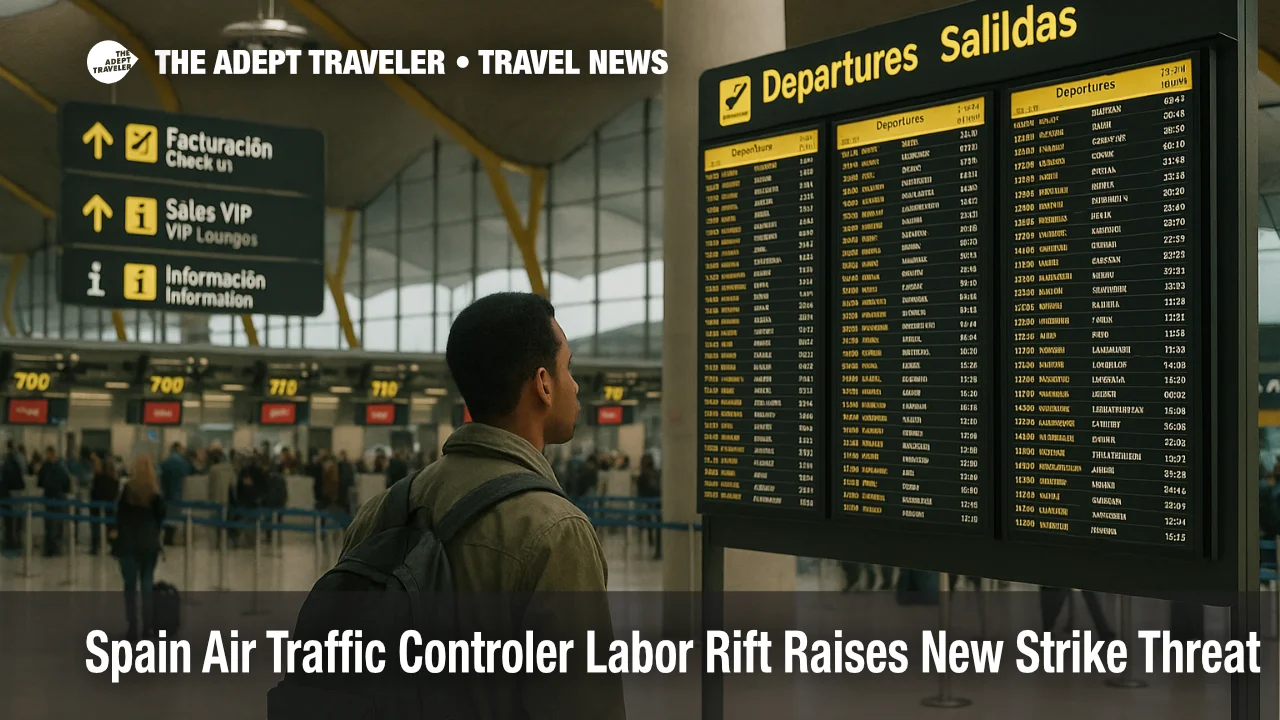Spain Air Traffic Control Labor Rift Raises New Strike Threat

Key points
- Spanish ATC unions warn of renewed industrial conflict at towers managed by Saerco
- Union statements ask the Transport Ministry to shift affected towers back to Enaire control
- Potential exposure includes Sevilla, Jerez, Vigo, A Coruña, La Palma, Lanzarote, and Fuerteventura
- Labor arbitration in 2024 ended a prior strike but disputes over compliance persisted in 2025
- Travelers to and within the Canary Islands face the greatest operational sensitivity
Impact
- Airports To Watch
- Sevilla, Jerez, Vigo, A Coruña, La Palma, Lanzarote, Fuerteventura, and Madrid Cuatro Vientos show the most direct exposure if walkouts or work to rule escalate
- Near Term Planning
- Keep flexible tickets and monitor airline email or app alerts daily, since any formal strike call would carry narrow time windows and rolling effects
- Connection Strategy
- Build longer layovers on itineraries that touch Canary Islands spokes and regional Spain routes where tower staffing is lean
- Rebooking Playbook
- If your flight is canceled, pursue free changes or refunds under airline policies, and favor morning departures when recovery options are widest
- On The Ground
- Allow extra time for airport processes and verify terminal, gate, and security status before leaving for the airport
Spanish air traffic control unions have renewed warnings about a possible return to industrial action centered on airport towers managed by private provider Saerco. Over the summer and into early autumn, unions USCA and CCOO accused Saerco of failing to meet staffing, scheduling, and pay terms that followed last year's arbitration, and urged the Transport Ministry to transfer affected towers back to the public provider, Enaire. While no fresh strike dates have been posted, the rhetoric, and the history, point to elevated risk at several regional airports.
Where the pressure is building
Reporting in Spain's business press described the liberalized tower network as one step from open conflict in April, citing thin staffing, extended shifts, and pay disputes at Saerco sites. Those concerns resurfaced in late July and August when USCA publicly pressed the government to move Saerco's towers to Enaire, naming Sevilla, Jerez, Vigo, A Coruña, La Palma, Lanzarote, and Fuerteventura, with particular sensitivity in the Canary Islands. Trade and local outlets echoed the same list.
Latest developments
Union channels and regional broadcasters warned again in late August that new protests and potential work stoppages could follow if talks stalled, highlighting the Canary Islands and Andalusia as especially exposed because of island connectivity and thin rosters. No nationwide ATC strike has been officially declared as of November 12, 2025, but the posture remains watchful.
Analysis
If a formal strike call arrives, it would likely target defined windows, for example, partial day stoppages or alternating shifts, rather than an open-ended walkout. Spain's network has proven resilient on en route control under Enaire, yet tower level actions can still slow operations at origin and arrival, especially on island spokes where rerouting options are limited. During the 2025 summer peak, Enaire emphasized that ATC attributable delays fell versus 2024, which suggests capacity exists to absorb some disruption, but tower staffing is the constraint at the named fields.
Background
Spain liberalized a subset of airport towers, awarding Saerco and other private providers multi year contracts. A prolonged tower strike that began before 2024 ended through binding arbitration that set wage increases from 2023 to 2026. In 2025, unions alleged non compliance and sought state intervention, which is the root of today's renewed strike risk.
Final thoughts
A Spain air traffic controller strike remains a threat rather than a dated event today. Travelers with itineraries that touch the Canary Islands or regional spokes should build buffers, watch union and provider statements, and keep changeable fares until the labor picture stabilizes.
Sources
- USCA pide que Enaire controle las torres de los aeropuertos de Saerco
- Los controladores aéreos, a un paso del conflicto laboral en las torres liberalizadas
- USCA y CCOO preparan nuevas manifestaciones en las torres de control gestionadas por Saerco
- Controladores aéreos avisan de huelga con afección en Canarias
- ENAIRE has faced the 2025 summer season with record traffic
- Aena adjudica el servicio de tránsito aéreo de aeródromo para 12 aeropuertos por un importe de 101.894.000 €
- La falta de controladores amenaza a Sevilla, Vigo, Lanzarote y otros seis aeropuertos
